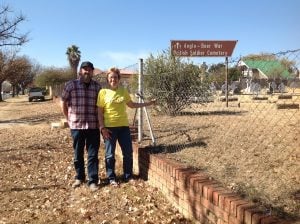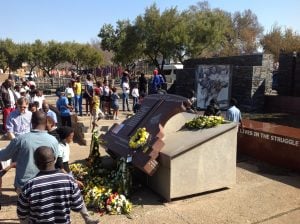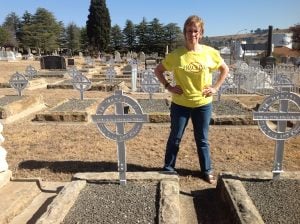All study of South Africa leads any outsider with sensibility to be appalled by the horrific institution of apartheid, which in Afrikaans, means “apartness.” This policy pervaded South African history, but was specifically and violently, specifically enforced by law from 1948 to 1994.
Looking at the sweeping history of South Africa in this epic story, from the earliest recorded humans (both in fossilized remains and in 15,000-year-old cave paintings) to most recent events, sheds light on how this mindset developed.
The Afrikaners–mainly of Dutch descendent, but through the generations becoming African-born, free-minded, tough bastards who had absorbed like-minded Protestants from other European countries into their ranks, truly believed that they were God’s chosen people in this “new land.” They used the Old Testament for guidance and followed, to the letter, God’s “commands” to the Israelites, believing they were God’s chosen every bit as clearly in this new African land as the Israelites had believed they were in Canaan. God commanded the Jews not to co-mingle with the Canaanites, and to subjugate the people in their path in their new promised land. The Boers (a term originally referring to farmers of Dutch descent) adhered to these commands, believing that God had chosen them exactly and entirely as he had chosen descendants of Abraham and Isaac to be his chosen people of Israel.
Also, if the Old Testament is our guide, Afrikaners weren’t the only people who quoted from Genesis to justify white supremacy. In Genesis 9, after Noah’s flood, Noah passed out drunk and naked in his tent. His youngest son, Ham–considered to be the father of African nations–walked in on his dad in this shameful state. In fact, according to law, it was an abomination to see your father naked. Ham transgressed, by accident, having no clue when he went to see his dad, that the dude was drunk off his ass, literally, and buck naked, in the tent. (We shan’t speculate here why the patriarch partied until he did some deed that caused him to pass out naked; it’s just the way the story goes). Stunned, Ham ran outside and told his brothers. Shem (father of Israel and Arab nations) and Japheth (father of European tribes) were mortified. When Dad finally came to, he didn’t know what had happened, and he asked his boys. Shem and Japheth tattled on Ham. Noah (who was the only one who had seriously done anything wrong) rose up and cursed Ham for his abomination, and swore that Ham’s descendents would forever serve the sons of Shem and Japheth. The stuff they don’t teach us in Sunday School! Read Genesis 9 if you don’t believe me.
How fair is that story? And how far would you go to use that as justification for lasting and far-reaching governmental policies that controlled peoples lives for centuries? Insane, right? Well, up until 1863 people used that same rationale in the United States, too.
At any rate, all this combined led the white Afrikaners in South Africa to truly believe God had ordained them to subjugate the blacks, to keep them inferior and overpowered. Reading and understanding this epic horror leaves me speechless, and my heart unable to comprehend such arrogance and cruel self-centeredness.
Once again, religion has been responsible for epic atrocities.
I made my reading list for Sabbatical over a year ago: Sabbatical plans have to be submitted in late October for the following year. I knew this book was epic, and long, but I hadn’t actually seen how long it was at that time. Perhaps I wouldn’t have put it on my list had I done this ahead of time. But I’m so very glad I read it.
My edition of the book (used from Amazon) is 1125 pages long. I decided to read it during November, when I would be visiting my daughter and her family (along with my grandson Alec and highly-anticipated new baby daughter–the point of my month-long visit), and probably wouldn’t get much writing done.
I finished it last night–Nov. 30, so I reached that goal. The book was amazing, and well-worth the read. I’m glad I put it on my list blindly.
From the inside flap: “Adventurers, scoundrels and missionaries. The best and worst of two continents carve an empire out of the vast wilderness that is to become South Africa. For hundreds of years, their rivalries and passions spill across the land. From the first Afrikaners to the powerful Zulu nation, and the missionaries who lived with both–all of them will influence and take part in the wars and politics that will change a nation forever.”
15,000 years ago, the San and Khoi-Khoi roamed and hunted the land that is now South Africa. The story starts with them.
in 1453, Prince Henry the Navigator from Portugal pushed his explorers to “discover” what lay at the southern end of Africa. Prince Henry died before realizing his dream, but this men did push farther south than any Europeans ever had before.
At the same time, the great Zimbabwe was being built by Black Africans, and the trading city of Sofala, through efforts of Africans, Arabs, Persians, Egyptians, and Asians from India, Malaysia, and Java. When the Europeans discovered the ruins of the great citadel of Zimbabwe (the city, not the present-day country, though it’s located there), the arrogant and ethnocentric Europeans, of course, pronounced that the great mining and architectural center had to have been built by those with Egyptian, Greek, or Israelite influence. Such amazing technology could not have been achieved by Africans. The beginnings of the horrific racism is obvious as early as the moment European feet touch African soil.
In the middle of the 17th century, the Dutch settlers moved in and established Cape Town as the stop-over place for Dutch East India Trading Company, and eventually the all-powerful Jan Companie, which tightly controlled the actions of all its employees, who were virtual serfs guarding the Companie’s holdings on the African continent. Eventually, these Dutch settlers, vineyard owners, businessmen, and farmers rebelled. Some moved east and north out of direct reach of the Companie. These farmers became called Boers. These Boers were fiercely independent, and fought ferociously for freedom…through the centuries. In the story, Michener follows generations of several families. One of them directly involved from the beginning of the Companie is the van Doorn family from 1648 until the end of the story. And all this insight into “The Companie” certainly changes my attitude about Company Gardens in Cape Town!  (See first photo).
(See first photo).
Huguenots (Protestants) arrived, by way of Amsterdam, but from France and Belgium, too. Because of the similarity of the Calvinist beliefs to that of the Dutch Reformed believers from Holland, they were mostly absorbed into the strain that eventually became Afrikaners (not called Afrikaner for quite some time, however). Du Pre brought from France an advanced ability to cultivate excellent wine grapes and wine-making skills. The skills were embraced, as well as the grape vine shoots carried all the way from Europe, but the French language was effectively extinguished by the Dutch-speakers within a generation.
All through this time, the Dutch language was being altered, accommodating aspects of Zulu, Xhosa, Hottentot, and other languages as well as even shades of English. It finally became a language distinct from true Dutch.
English settlers figured more and more powerfully into the South African politics and landscape. When the British Empire claimed South Africa as its own by 1800, the Boers refused to submit to English authority. By mid-century (1850s), skirmishes between the two forces were commonplace.
The great and famous Zulu king, Shaka, swept across eastern South Africa in the early 1800s, uniting more land than had been held under one ruler before. This novel chronicles the story of Shaka’s chief advisor, so the great leader is shown as historians agree he really was: a brilliant strategist, but an insane ego maniac (is that anything unique?). He was ruthless both on the battlefield and within his kingdom with anyone who dared challenge him.
His successor, Dingane, created an elaborate and highly sophisticated royal capital. He’s memorialized by white historians for signing a treaty with Piet Retief, a Boer, and then slaughtering Piet and his men at a celebration banquet. Any student of history feels that such action isn’t unjustified. Piet Retief, as Michener paints him, makes this slaughter not even surprising.
The English exercised more and more authority, and the Boers rebelled with increasing vehemence until the famous English-Boer War from 1899-1902. The bloody battle resulted in the defeat of the Boers, but not of their spirit, but certainly left a bloodbath behind. Unforgivable was the English action of removing women and children from a conquered area, burning out the left-behind farms into total obliteration, and placing conquered peoples into concentration camps. 28,000 Boers (children, women, and even men) died in the “white” camp. Of course, black and white camps were separate. Black statistics were not kept efficiently. The first count was 14,000 deaths, but examination of graveyards later puts the death number at a minimum of 20,000.
I don’t know how anyone can read this history without getting more and more angry and sadder and sadder.
The concentration camps, always an inexcusable atrocity, solidified Boer/Afrikaner hatred of the English. It melded their determination to be free of English control into a steel will, even after military defeat. Strange, though that these Afrikaners who lived and were more than willing to die for freedom, didn’t even entertain the thought that the Black Africans who had shared the land with them might feel the same way about freedom.
In 1948, the Nationalist Party–basically the Afrikaner party of choice–won the election. Black at this time, were of course not allowed to vote.That began the reign of terror known as apartheid.
 To the right is a English Boer War cemetery Scott and Ann Fee and I happened upon in Bethlehem, South Africa, on our own trek across the country.
To the right is a English Boer War cemetery Scott and Ann Fee and I happened upon in Bethlehem, South Africa, on our own trek across the country.
As I mentioned earlier, the sweeping epic South African historical novel reaches from 13,000 BCE to the 1970s. The book was originally published in 1980, so that’s as far as Michener could take the thoroughly researched story. Mandela was released from prison on February 11, 1990, so his name isn’t even mentioned in the story. Several political voices are included, but not Mandela, Steve Biko, Sobukwe, Walter Sisulu, Oliver Tambo, or other heroic names we know from South African history and this perspective.
In the 1976, the Soweto uprising occurred, so that event, as well as the Sharpeville massacre play a part in the last segment of the book. In both cases, Blacks were peacefully protesting the unjust laws of the land and were gunned down where they marched or stood. Both deserve entire blog posts all their own.
 This third picture is a memorial at the site of the Soweto “Uprising” where school children protested being taught in Afrikaans, and were shot down in the street.
This third picture is a memorial at the site of the Soweto “Uprising” where school children protested being taught in Afrikaans, and were shot down in the street.
Amazon says: “James A. Michener’s masterly chronicle of South Africa is an epic tale of adventurers, scoundrels, and ministers, the best and worst of two continents who carve an empire out of a vast wilderness. From the Java-born Van Doorn family tree springs two great branches: one nurtures lush vineyards, the other settles the interior to become the first Trekboers and Afrikaners. The Nxumalos, inhabitants of a peaceful village unchanged for centuries, unite warrior tribes into the powerful Zulu nation. And the wealthy Saltwoods are missionaries and settlers who join the masses to influence the wars and politics that ravage a nation. Rivalries and passions spill across the land of The Covenant, a story of courage and heroism, love and loyalty, and cruelty and betrayal, as generations fight to forge a new world.”
I have much more to say, but this is already too long for most sane humans to read, so I’ll stop. I haven’t ranted much about those heroes who protested so bravely against apartheid in the last half of the 20th century, but plenty of other blog posts–and much of my South Africa culture and history class–deal with much of that era.
I found this interesting website about Michener’s creation of this epic story, however:
Website with Michener’s notes about the creation of The Covenant.
Now I really will close out. I’m so grateful I read this book. Thank you, Dr. Brian Fors, for recommending it.
Michener, James. The Covenant. Fawcett, 1987.




I’m going to keep this short.
Most of what you read are propaganda.
These people you read about were a minority among the Afrikaner. Even today they refer to themselves as the “Israelite s”.
Secondly, I like my father grew up in a black township, mingled with black people. He was a WW2 veteran. We lived post-Apartheid, llllllong before Apartheid fell 1994. This goes against the narrative of left wing propaganda.
Our lives are being deleted as if it never happened. The perception created by Apartheid propaganda was that black and white people never mingled. It’s a lie. Yes, they didn’t in Johannesburg, but South Africa is and was a huge place. We lost the propaganda war. Now America is facing the same challenges, with media bias.
These lies are now made “fact”, and believed by most people worldwide.
I came from a small town, and saw on TV, what people abroad saw on TV. To me it was “far flung” country totally alien to my experiences under Apartheid. There’s two sides to this story being “sold”.
I saw the good under Apartheid, and later when i joined the army, also saw the bad side. Once again, the bad side was never shown to the outside world the evil we were fighting against. It went against the Apartheid Narrative.
One day, the world will find out more about the “other side” only once Amerika goes through the same cycle of Marxism, and then understand how they were duped.
History is repeating itself in South Africa, and a 100 years from now South Africa will be a different country, people like myself will be proven right. Time is our friend.
http://www.amazon.com/Into-Cannibals-Pot-Lessons-Post-Apartheid/dp/0984907017
http://WWW.HENRILERICHE.COM
Thanks for your reply, Henri! I am not predisposed to hold an opinion as the correct one in the world in any way. I also know the media is rarely accurate when portraying sweeping statements about politics, either about what’s happening in the United States or in South Africa. The book link you sent is interesting, too–that “civilized” societies wither from within or are killed off by westernized societies. I think that’s part of what Michener was trying to say. Have you read The Covenant? I would venture to guess that there are a few characters in the novel not unlike your father. I’m interested in what you have to say. I’m not sure what you are arguing with me though, so I’d love to hear. You say you lived post-apartheid during apartheid because you weren’t in one of the big cities. That says to me that you believed people could get along with others as people. Your response indicates that you saw both good and bad about apartheid, but that you “mingled” in a positive way with black people. So I’m not sure what you’re saying about what is the propaganda I’ve been fed, or about what is the lie. I think we all know that by no means were/are all Afrikaners like those claiming to be the “chosen people,” but as I understand it, that attitude fueled the apartheid government. What do you think about that? Thanks again for writing!